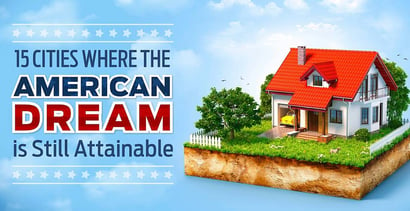

We’ve all seen the click-worthy lists full of the “best places to live,” complete with the glossy photos of tree-lined streets, sandy beaches, and hip downtowns. What many of these lists don’t think about, however, is the high cost of living in many of those places.
For the average person, the search for a city to call home has to balance the quality of life with the cost of that life, as living outside your means for a supposedly better quality of life is a recipe for financial disaster.
But, as prices continue climbing ever higher, it begs the question: Is the American Dream still attainable? Or have we all been priced out of a high quality of life? As our study found, you can still have it all — at least, you can in these 15 cities that offer quality living without the high cost.
Map | Study Results | Study Methodology
Cities Map
In our study, we uncovered 15 cities across the country that balance a high quality of life with a low cost of living.

While many of the most expensive states didn’t make the cut, our list includes a range of regions, climates, and city sizes suitable for a wide variety of people.
Results of Our Study
Although the true cost of living in any particular location will vary based on your — and your family’s — needs, basic factors, like housing prices and income levels, can be a good way to judge the financial feasibility of living in a city.
Quality of life is also a subjective factor, as an ideal life for one family may not suit every family. Similar to the cost of living, however, we can use factors — such as commute times and educational opportunities — that are common concerns for most residents to get an idea of the general quality of life.
1. Sioux Falls, South Dakota
Located along the eastern edge of South Dakota, Sioux Falls is named for the Sioux Tribe that called it home and the iconic waterfalls of the Big Sioux River. The town was founded by pioneers in 1856, and it has been growing steadily ever since, today sporting a population of more than 165,000 people.
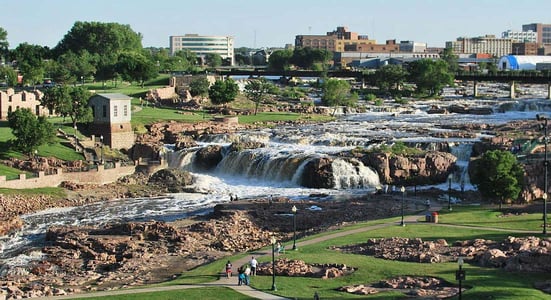
Photo Credit: Seabear70 [CC BY 3.0], from Wikimedia Commons
Employment levels in Sioux Falls have shown regular year-over-year growth, and the top industries for employment include healthcare and social assistance, retail, finance and insurance, and manufacturing. The average employee has a commute of just 16.4 minutes.

Buying a home in Sioux Falls, where the median property value of just $161,500 (a stunning $60,000 less than the national average), is a dream many residents can realize. Thanks to its affordable housing prices, Sioux Falls has an average homeownership rate of 60.9%.
Educational opportunities are diverse, with multiple schools at each grade level. Students also have several options for higher education, including the University of Sioux Falls and the Southeast Technical Institute.
“If someone has a vision of a perfect life, this city is one to be able to unfold it. Real estate is cheaper than the national average and is constantly expanding. Jobs, large and small, are booming. Unemployment is half of the national average. The city is very active! Sioux Falls is beautiful with trees in every direction. It seems every year this city just keeps getting better.” — Review of Sioux Falls, South Dakota
Both indoor and outdoor activities are also plentiful in Sioux Falls. For example, after a visit to the beautiful Falls Park, residents can enjoy a show at the Husby Performing Arts Center or attend an event at the Denny Sanford Premier Center.
For residents who prefer something a bit more active, the Sanford Pentagon hosts a range of local and national sporting events, and the Drake Springs Family Aquatic Center is an ideal summertime retreat.
Art enthusiasts can explore the free Museum of Visual Materials or browse the Eastbank Art Gallery’s collection of regional fine art. And spend an afternoon learning about South Dakota’s wildlife and history at the Great Plains Zoo & Delbridge Museum of Natural History.
2. Fort Wayne, Indiana
The city of Fort Wayne, Indiana, is three rivers converge: the St. Mary’s River, the St. Joseph River, and the Maumee River. The town itself was named after General Anthony Wayne, who built the first American fort on the location in 1794. Now the second-largest city in Indiana, Fort Wayne boasts a population of more than 260,000.
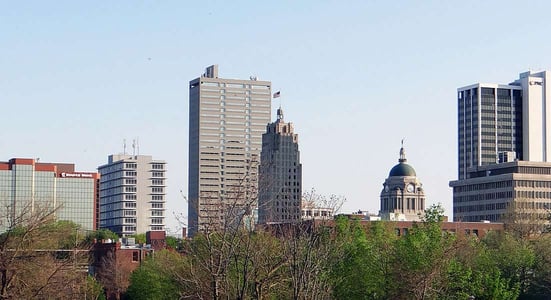
Photo Credit: Momoneymoproblemz [CC0], from Wikimedia Commons
Employment options are varied, as Fort Wayne is home to a number of different industries. Employment is highest in the manufacturing industry, though the healthcare, retail, and hospitality industries also employ many residents. Workers spend an average of 20.2 minutes commuting to and from work.

Many residents in Fort Wayne own their own home — the city has a 60.8% homeownership rate — which makes sense given that the median home price is just $108,400, almost half the national average.
Residents can receive a solid education in Fort Wayne, which has the largest public school district in the state. For higher education, options include both Indiana University and Purdue University extensions located in Fort Wayne, and the city is also home to the Indiana Institute of Technology.
“There is a thriving community college (about 12,000 enrolled annually), Indiana University and Purdue University share a Fort Wayne campus (called IPFW), and private colleges with campuses are Trine University, Indiana Tech University, and University of St. Francis.” — Review of Fort Wayne, Indiana
Residents aren’t likely to run out of things to do in Fort Wayne, which offers a little something for everyone. Culture seekers can take in a show at the Fort Wayne Civic Theater or enjoy a performance by the Fort Wayne Philharmonic at the 90-year-old Embassy Theatre.
For something a little more rough-and-tumble, residents can head to the Allen Co. War Memorial Coliseum to catch the Fort Wayne Komets in an exciting night of hockey, or hit Parkview Field for a TinCaps baseball game.
Kids will get a kick out of a day at Science Central to explore over 200 permanent and hands-on exhibits. And the Fort Wayne Children’s Zoo houses more than 40 acres of animals and rides, including the popular Sky Safari Ride and the Crocodile Creek Adventure Ride.
3. McAllen, Texas
Nestled in the Rio Grande Valley in the southern tip of Texas, McAllen was established in 1904 by its namesake, John McAllen, as a depot for the St. Louis, Brownsville, and Mexico Railway. Though once primarily an agricultural region, McAllen has grown into a thriving metropolitan area with a current population of more than 138,000.
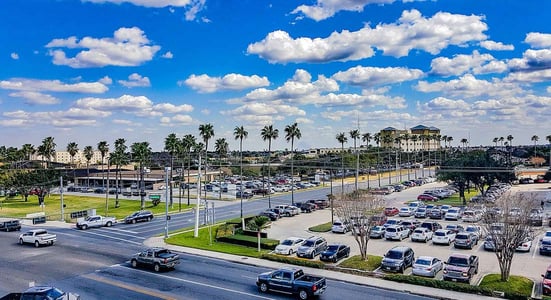
Photo Credit: Anthony Acosta [CC BY-SA 4.0], from Wikimedia Commons
Residents commute an average of 19.2 minutes for work. Despite the city’s history, agriculture is only a minor industry in McAllen these days. The healthcare and social assistance industry is the largest source of employment, followed by educational services, retail, and hospitality industries.

Homeowners are common in McAllen, with 60.6% of residents owning a home. Housing prices help make homeownership affordable, as the median home value is a low $117,500, which is more than $100,000 below the national average.
McAllen values education and the McAllen Independent School District carries an “A” rating. Higher education students have several options, including the popular South Texas College as well as the Rio Grande Valley extension of the University of Texas.
“McAllen Texas is a great place to raise a family. I lived there for 25 years before relocating to California for a job. Overall, cost of living makes this south Texas town an excellent choice for anyone looking for warmer weather and close travel time into Mexico.” — Review of McAllen, Texas
There’s no shortage of things to do for residents of McAllen. For starters, the McAllen Convention Center plays host to a range of events all year long. And the state-of-the-art McAllen Performing Arts center provides a variety of nationally recognized productions, including a number of hit Broadway shows.
For a day of learning, head over to the International Museum of Arts & Sciences to experience hands-on science exhibits and a number of original collections of art, including lithographs by Pablo Picasso and works from local and Mexican artists.
While McAllen has lots to do indoors, it doesn’t forget the great outdoors, either. the McAllen Nature Center is a 33-acre nature site that includes 1.6 miles of scenic trails. And stop by Town Lake at Fireman’s Park for a day of boating or fishing.
4. Des Moines, Iowa
Named after the nearby Des Moines River, Des Moines, Iowa, was incorporated in 1851, and designated the state’s capital in 1857. The city has been Iowa’s most populous for well over 100 years and today is home to more than 214,000 people.
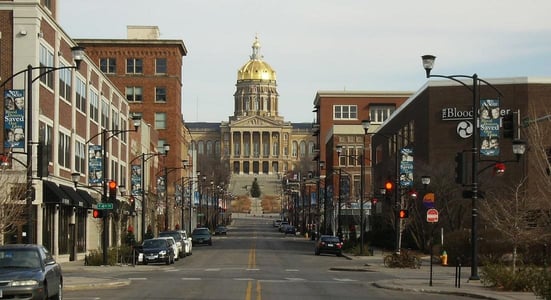
Photo Credit: Iowahwyman [CC-BY-SA-3.0] from Wikimedia Commons
It takes the average resident 18.8 minutes to commute through Des Moines. Healthcare and social assistance is the most prominent industry, though retail is a close second. The finance and insurance industry and manufacturing industry round out the largest employment sectors.

Housing prices are fairly reasonable in Des Moines, averaging around $120,000, or nearly $100,000 less than the U.S. average. While housing prices have increased year over year, 60.2% of Des Moines residents still own their home.
The Des Moines Public Schools district is the largest in the state, boasting 63 schools across grade levels. The city also has several colleges, including Drake University, Grand View University, and an extension of the University of Iowa.
“You shouldn’t have a day where you can’t find something to do! Des Moines has a wonderful Civic Center, Wells Fargo Arena, Hy-Vee Hall, Hoyt-Sherman Place, the Science Center, Des Moines Art Center, State Historical Bldg., Botanical Center, the State Capitol — and these are just the major sites! There is much local talent, from sports to ballet and everything in between. Much of it is very inexpensive too!” — Review of Des Moines, Iowa
As you’d expect out of a state capital, Des Moines has a huge variety of activities for residents to enjoy. Sports fans can head to the Wells Fargo Arena to catch the IFL’s Iowa Barnstormers or root on the Iowa Wild in a fast-paced AHL hockey game.
Residents can get their learning fix at the Science Center of Iowa, which offers tons of hands-on science exhibits and a big-screen IMAX theater. And stop by Blank Park Zoo to see animals from all over the world, including the new Australian Outback exhibit.
Of course, while long winters mean Des Moines residents have a lot of indoor activities, they also take advantage of the great outdoors all year long. Adventureland Park is a summertime favorite, as is the Greater Des Moines Botanical Garden. Or, residents can just explore the hundreds of parks and more than 800 miles of trails throughout Greater Des Moines.
5. Grand Rapids, Michigan
While people have lived in the Grand River Valley in Central Michigan for thousands of years, the modern-day Grand Rapids was born in 1850 when the city was incorporated with a population of 2,686. Today, Grand Rapids is the second-largest city in Michigan and has a population of around 194,000.
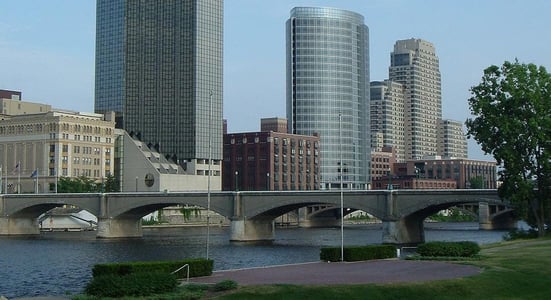
Photo Credit: Grguy2011 [Public domain], from Wikimedia Commons
Manufacturing is alive and well in Grand Rapids, employing more residents than any other industry. Healthcare and social assistance isn’t far behind, however, with retail and hospitality also important sources of employment. The average Grand Rapids resident has a commute of around 18.6 minutes.

A low median housing price of just $113,600 and property taxes that are well below average make homes relatively affordable in Grand Rapids. While lower than some of our other cities, the homeownership rate for Grand Rapids is 54.3%, meaning more people own than rent their home.
In addition to a robust K-12 education system, Grand Rapids is home to multiple higher education institutions, including a number of private religious schools such as Aquinas College, Calvin College, and Cornerstone University. Grand Rapids Community College is also popular, as are several extensions of other regional universities.
“I have lived in Grand Rapids for four years. Grand Rapids is the most friendly, clean, and beautiful city I have ever lived in (compared to Pittsburgh, PA, and Nashville, TN). Grand Rapids is covered with beautiful art, from sculptures to paintings to live performances that occur constantly in the city center where a large outdoor open auditorium is located. There are hidden lakes and trails throughout the city, which is interesting because, even if you live there for years, you will continue to find new natural beauty at your doorstep.” — Review of Grand Rapids, Michigan
Grand Rapids has an array of activities for residents of all ages, including both indoor and outdoor adventures. The museum scene is strong in Grand Rapids, with everything from the Grand Rapids Art Museum to the Gerald R. Ford Presidential Museum. If performance is more your jam, catch a live Broadway show at the DeVos Performance Hall.
The John Ball Zoo, home to more than 1,800 animals, is just two miles west of downtown Grand Rapids. Residents looking for some fresh air can explore the larger-than-life installations at the Frederik Meijer Gardens & Sculpture Park or shop for fresh local produce at the open-air Downtown Market.
And sports fans have no shortage of teams to cheer on, including the AHL’s Grand Rapids Griffins — who hit the ice at the Van Andel Arena — and the Grand Rapids Drive, the NBA Development League affiliate for the Detroit Pistons.
6. San Antonio, Texas
The city of San Antonio was born as a Spanish mission, the Misión de San Antonio de Valero — better known today as The Alamo. It took many years for the population of San Antonio to recover from the Texas Revolution and the battle that brought the mission its fame. But recover it did; modern San Antonio is the second-largest city in Texas and the seventh-largest in the U.S., with a population of over 1.4 million.
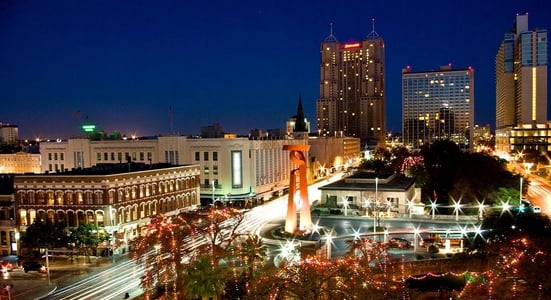
Photo Credit: Corey Leopold [CC BY 2.0], from Wikimedia Commons
An unfortunate side effect of a big city means a longer commute, and San Antonio workers are commuting an average of 24.1 minutes. Employment options include a variety of industries, but healthcare and social assistance is the leading industry. Retail, hospitality, and educational services are also prime industries in San Antonio.

Unlike most big cities, real estate isn’t outrageously expensive in San Antonio; the median property value is just under $134,000, more than $85,000 less than the national average. Despite housing prices being low, San Antonio has one of the lower homeownership rates at just 53.6%, though more residents still own than rent their home.
San Antonio’s educational system is vast, with more than 19 independent school districts and 30 private and charter schools. The city is also home to 31 higher education institutions, including the University of Texas at San Antonio, Texas A&M University-San Antonio, and the private Trinity University.
“I don’t know why this city isn’t ever on the lists of the lowest cost of living. Just look at housing online and you’ll see what I mean. Those who move in from out of state buy so much more house than what they had before, they feel like they’re in a mansion, so to speak.” — Review of San Antonio, Texas
Rich in history, San Antonio has many museums and sites for residents to soak up centuries of culture — including the famed Alamo. Or, residents can discover natural history through the Witte Museum’s dozens of exhibits or by exploring the underground expanse of the Natural Bridge Caverns.
Of course, San Antonio isn’t just for history buffs. At the AT&T Center, residents can catch a San Antonio Spurs basketball game or cool off at a San Antonio Rampage hockey game, and Toyota Field plays host to the San Antonio FC soccer team.
And don’t forget life’s luxuries. Residents can head over to Pearl, an old brewery turned mixed-used retail and dining space, for the hottest local cuisine and boutique shopping. The River Walk, or Paseo del Rio, is an easy way to explore it all while just steps away from the scenic San Antonio River.
7. Knoxville, Tennessee
The area around modern-day Knoxville, Tennessee, has been inhabited for over 1,000 years, and the city itself has been established since the late 1700s, serving as the capital of Tennessee until 1817. But, while no longer the state’s capital today, the city is still one of its largest with a population of roughly 184,000.
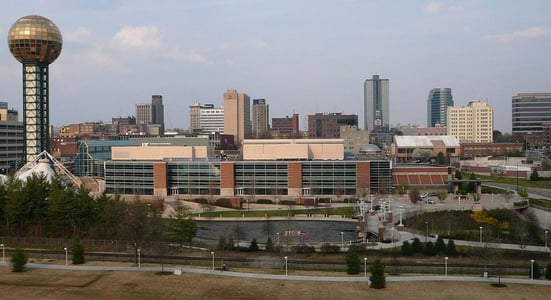
Photo Credit: Nathan C. Fortner [CC-BY-SA-3.0], from Wikimedia Commons
Commutes are fairly typical at an average of 19.7 minutes, and Knoxville is home to more than 19,000 businesses. Retail is the largest industry in the city, though jobs in healthcare and social assistance, hospitality, and educational services are also common.

Homes in Knoxville are cheaper than homes in many major cities, with a median property value of $120,300 — around $100,000 less than the national average. At the same time, the homeownership rate is just 45.9%, meaning more residents rent than own.
The Knox County Schools system oversees 89 primary and secondary schools, including five magnet schools and a STEM academy. For higher education, residents can head to the main campus of the University of Tennessee or the Tennessee College of Applied Technology Knoxville extension.
“Whether you are single or have a family, there is something for everyone. Market Square in downtown Knoxville and The Old City are definitely worth a visit. Nightlife is great as well. Movies on Market Square, Boomsday (Google that), Mardi Growl, Biscuit Festivals, Chili Cook-off, Rossini Festival, and so much more! Also, we have Pigeon Forge and Gatlinburg within a short distance. No boredom to be had here. There is always something going on in AND around Knoxville that you are sure to find plenty of life out there within a short distance.” — Review of Knoxville, Tennessee
Whether you want to experience a millennium of history or enjoy modern dining and entertainment, Knoxville has something for you. Dive into Knoxville’s past at the East Tennessee History Center, or head to the McClung Museum of Natural History and Culture to go even further back in time.
Sports lovers can catch a University of Tennessee football game at Neyland Stadium, or head over to the Knoxville Coliseum to see some hockey with the Knoxville Ice Bears.
If you’re looking for a night out, the 90-year-old Tennessee Theatre offers the chance to see nationally acclaimed shows, including Broadway hits as well as performances by the Knoxville Opera Company and the Knoxville Symphony Orchestra.
8. El Paso, Texas
Located on the border between the U.S. and Mexico, El Paso, Texas, has reportedly been populated for as many as 12,000 years. The county of El Paso wasn’t established until 1850, however, and it was only after the Civil War that the area’s population began to grow at a rapid pace. Today, El Paso has a population of more than 683,000.
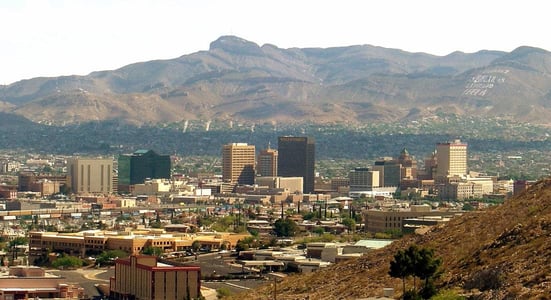
Photo Credit: Smguy101 [Public Domain], from Wikimedia Commons
The city is home to more than 19,000 businesses, with the healthcare and social assistance industry the dominant employer. The educational services industry isn’t far behind, and the retail and hospitality industries are also big sources of jobs for El Paso residents.

As you’d expect from its low cost of living, housing prices are fairly reasonable in El Paso, with a median housing price of $125,300, which is more than $90,000 below the national average. More residents own than rent their home as a result, and the homeownership rate is 57.9%.
Primary and secondary students are split into four primary education districts across the city. Higher education students have multiple options, though the University of Texas at El Paso is the largest public university in the region. Students can also attend nearby New Mexico State University, where El Paso residents enjoy in-state tuition.
“When I first heard I was moving to El Paso, I thought I would hate it. After only six months, the opposite was true. I have found the city to be very family oriented, safe, great climate, and affordable. The town really supports the University of Texas – El Paso. Some of the many places to see or do are The Plaza Theater, The Lynx Museum, the state park, Music Under the Stars, mountain biking, UTEP football tailgating, and much, much more.” — Review of El Paso, Texas
El Paso residents have many great options for things to do, including getting out and enjoying the city’s warm climate. Outdoor enthusiasts can hike through Franklin Mountains State Park or rock climb at the Hueco Tanks State Park & Historic Site. For less active outdoor fun, check out the El Paso Municipal Rose Garden or the popular El Paso Zoo.
History lovers can explore the area’s many historic sites, including the Historic Mission Trail and the Buffalo Soldier Memorial. The El Paso Museum of Art features a permanent collection of over 7,000 works from the Byzantine era through the present day, including pieces from notable American, Mexican, and European artists.
Adventure Zone offers a variety of active entertainment, including an extensive go-kart course and an aquatic bumper cars ride. Residents can also check out an El Paso Chihuahuas baseball game at Southwest University Park, or catch an amateur game at one of the city’s 100-plus sports fields for youth and adult sports alike.
9. Omaha, Nebraska
Once largely Indian land, the city of Omaha, Nebraska, was founded in the mid-1800s after the Omaha Tribe sold the land that made up the Nebraska Territory. Omaha’s population has grown substantially since that time, and, while not its capital, Omaha is the largest city in Nebraska, sporting a population of more than 460,000.
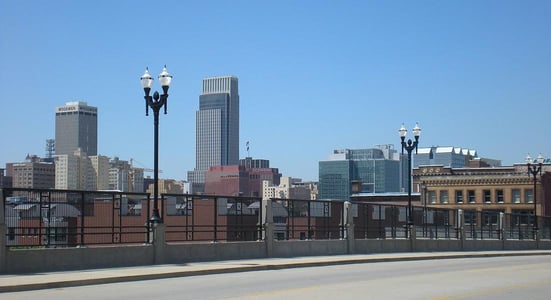
Photo Credit: JonClee86 [CC BY-SA 3.0], from Wikimedia Commons
Most residents work for one of the city’s more than 37,600 businesses. Healthcare and social assistance is the largest industry in Omaha, though the retail industry is also a major source of employment. Manufacturing and education services round out the city’s top four employment industries.

Buying a home is a little more expensive in Omaha than in some of our other cities — the median property value is $149,900 — but residents still pay around $70,000 less than the national average. Owning a home is more common than renting, with a homeownership rate of 56.6%.
The Omaha Public Schools district is the largest school distinct in Nebraska, and it oversees more than 75 primary and secondary schools. The city is also home to 11 colleges and universities, including the University of Nebraska Omaha and the top-rated Creighton University.
“I moved to Omaha from Southern California in November of 2017. Housing is more affordable, food is more affordable, gas is more affordable, commute to work decreased drastically. There are plenty of jobs in Omaha and it has been my experience that they pay much better and offer many more perks than jobs I have had in California.” — Review of Omaha, Nebraska
With a wide range of activities — starting with the Henry Doorly Zoo and Aquarium, which is ranked as one of the world’s best zoos — Omaha residents are rarely without something to do. For more family fun, head over to the Omaha Children’s Museum to explore hands-on exhibits and daily educational programs.
Adult residents looking for a little “grown-up” fun can try their luck at any of three different area casinos, or enjoy a night on the town at one of the city’s many boutique bars and music venues. Baseball fans can catch a Storm Chasers game at Wener Park, and the TD Ameritrade Park has hosted the College World Series since 2011.
The Omaha area is also a great place for residents who love to get outdoors, offering a number of trails and parks around the city. Thrill seekers can hit the Fun-Plex, Nebraska’s largest water park, or spend an afternoon at Boulder Creek Amusement Park.
10. Oklahoma City, Oklahoma
Once part of the Unassigned Lands, Oklahoma City was established in 1889 in an unusual event called “The Land Run” that involved roughly 10,000 homesteaders staking a claim and settling in the area. The city’s population has grown steadily since its establishment, and, with a population of nearly 630,000, Oklahoma City is both the largest city in Oklahoma and the state’s capital.
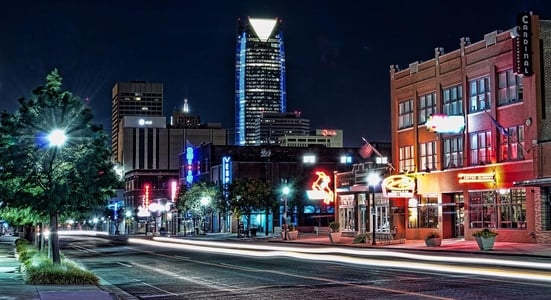
Photo Credit: katsrcool [CC BY 2.0], from Wikimedia Commons
Oklahoma City is the center of business in Oklahoma, and the town boasts nearly 59,000 businesses. Jobs are spread across a variety of industries, with the healthcare and social assistance, retail, construction, and hospitality industries being the largest.

Oklahoma City has some of the more expensive housing on our list, with a median property value of $157,100. However, the national price tag is more than $60,000 higher than property in Oklahoma City. The homeownership rate is 59.2%, which reveals that residents are more likely to own a home than rent.
Residents have several colleges and universities from which to choose, including multiple campuses for the University of Oklahoma. Oklahoma City University, formerly Epworth University, is also a popular choice and is known for its performing arts programs.
“I’ve lived all over the world: Cuba, Israel, Japan, Germany, and several other states. Oklahoma City is the easiest, most affordable and comfortable place I’ve ever lived. Traffic problems are minimal. You can usually get from one end of the city to the other in 20 minutes or less and it takes very little longer in rush hour. The cost of living is the best in the nation, people are very friendly and helpful, jobs are plentiful, and homes are very affordable and appreciating even during this bad housing era.” — Review of Oklahoma City, Oklahoma
As the state capital, Oklahoma City has a huge offering of things to do for residents of all interests. For naturalists, the Myriad Botanical Gardens & Crystal Bridge Tropical Conservatory provides year-round greenery, and the Oklahoma City Zoo is home to over 2,000 animals from across the globe.
Sports enthusiasts can cheer on the Oklahoma City Thunder at a basketball game at the Chesapeake Energy Arena, or root for the OKC Energy FC soccer team at the Taft Stadium. Baseball fans aren’t left out — the Oklahoma City Dodgers can be seen at the Chickasaw Bricktown Ballpark all summer long.
Oklahoma City is also renowned for its horse shows, hosting many top national and world championship horse shows each year, including the World Championship Barrel Racing Futurity and the International Finals Rodeo. And after the rodeo, don’t forget to check out the National Cowboy & Western Heritage Museum.
11. Toledo, Ohio
The first Europeans in the region that now makes up Toledo, Ohio, were French trappers and fur traders, and the area wasn’t settled by Americans until after the Revolutionary War. The city of Toledo itself was the result of a merger between two towns in 1833. Modern-day Toledo, nicknamed The Glass City, is the fourth-largest city in Ohio with a population of more than 278,000.
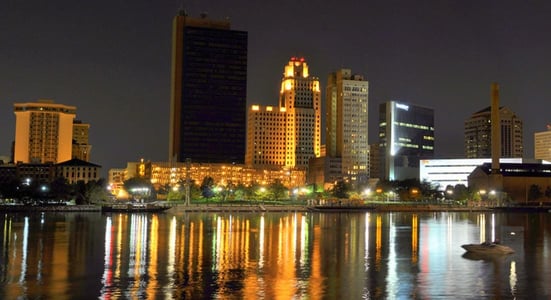
Photo Credit: NorthernMagnolia [CC BY-SA 3.0], from Wikimedia Commons
Commutes in Toledo are fairly typical, with the average resident commuting 19.9 minutes to one of the city’s nearly 18,000 businesses. Healthcare and social assistance is the largest industry in the city, followed by the manufacturing, retail, and hospitality industries.

Although incomes aren’t the highest in Toledo, housing prices are equally diminutive, and the median home price is just $79,100. Despite low prices, Toledo residents seem to prefer to rent over buying, as the homeownership rate is only 48.2%.
The University of Toledo is the largest higher education institution in the city, graduating more than 4,000 students a year, but residents can also attend Mercy College of Ohio, a school that specializes in health sciences degrees.
“I have lived in Toledo, Ohio for about 7 years now. Toledo has one of the highest qualities of life I have experienced. Here are some highlights I enjoy: revitalized Downtown, #1 art museum in Ohio, amazing Metroparks, easy commute, affordable housing, farmers markets, [and the] #2 zoo in the country.” — Review of Toledo, Ohio
Toledo residents looking for activities can find plenty of options, from enjoying a good sporting event to strolling through a local museum. The Toledo Mud Hens play minor league baseball at Fifth Third Field, and fans can catch ARCA Racing at the Toledo Speedway.
The Toledo Zoo & Aquarium is over 62 acres of wildlife and exhibits home to more than 4,700 species from around the world. Explore Toledo’s past at the Toledo History Museum, or get a broader view at the American Civil War Museum of Ohio.
Residents looking for adventure can head over to nearby Cedar Point Amusement Park, which features 72 rides, including 16 high-speed roller coasters. For something a little tamer, explore the Imagination Station, Toledo’s popular Science Center, which offers hundreds of interactive and hands-on exhibits.
12. Louisville, Kentucky
The city of Louisville, Kentucky, was said to have been first founded by Col. George Rogers Clark on Corn Island in 1778. The official town charter was approved in 1780, and the city was named for King Louis XVI of France. The river influenced much of the city’s growth, and the population has seen a steady increase to today’s 616,000 people.
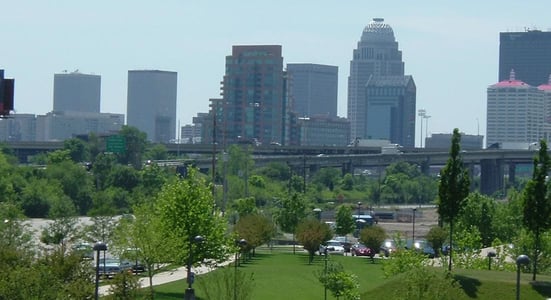
Photo Credit: Censusdata [CC BY 3.0], from Wikimedia Commons
The healthcare and social assistance industry is the largest in Louisville, though many jobs are also found in the manufacturing, retail, and hospitality industries. All told, there are nearly 53,000 businesses in the Louisville area.

Housing in Louisville is around $70,000 cheaper than the U.S. average, with a median housing price of $150,900. At 57.8%, the homeownership rate indicates that Louisville has more residents who own their home than rent it.
The Jefferson County Public Schools system encompasses more than 100,000 students attending 173 schools. Louisville also has six four-year universities, including the University of Louisville and several private Catholic and Christian universities. The town also is also home to the Southern Baptist Theological Seminary.
“Louisville truly has everything! From all the seasons to every kind of cuisine you could want… Louisville has it. Great cost of living, plenty to do, friendly people, it’s a great place to raise a family.” — Review of Louisville, Kentucky
Finding something to do in Louisville is easy for residents of all ages. For adults, the city presents an ideal location to launch an exploration of Bourbon Country and some of Kentucky’s best bourbon. Or try your luck at Derby City Gaming or the French Lick Casino.
Families can find plenty to do, as well, including the nearby Atlantis Water Park. For an educational afternoon, try the Bernheim Arboretum & Research Forest, the Kentucky Science Center, or the Frazier History Museum. And get outdoors to discover the Scenic Loop of Cherokee Park in downtown Louisville.
Of course, no resident of Louisville can forget they live in horse country — the city is home to the famed Churchill Downs racetrack that hosts the Kentucky Derby. For the full experience, be sure to stop by the Kentucky Derby Museum to see over 100 years of racing history.
13. Jacksonville, Florida
Home to North Americans for more than six thousand years, the region of modern-day Jacksonville, Florida, was first explored by Europeans in the early 1500s. The city got its current name — Andrew Jackson, who would eventually become president — in the 1800s. Today, Jacksonville is one of the largest cities in Florida, with a population of more than 867,000.
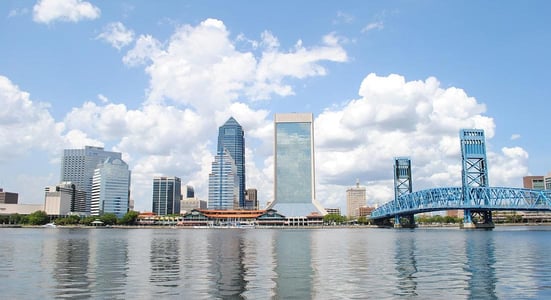
Photo Credit: AndrewAvitus [CC0], from Wikimedia Commons
The city has more than 70,000 businesses spread across several industries, though the health and social assistance industry is the largest. The retail, finance and insurance, and hospitality industries are also major sources of employment.

Median housing prices in Jacksonville are some of the highest on the list at $157,800, though they’re still well below the national average of $221,000. Jacksonville has a homeownership rate of 56.6%, showing that owning a home is more popular than renting.
Primary and secondary education is overseen by Duval County Public Schools, which includes more than 123,000 students and 172 schools. The University of North Florida is the largest higher education institution in Jacksonville, though Jacksonville University and Edward Waters College are also popular.
“Jacksonville is a great place to live with access to the beach, river, Intracoastal, affordable housing, affordable restaurants, parking, etc. Not to mention we are close to Amelia Island, St. Augustine, springs and rivers more inland, Savannah, Orlando, etc. I highly recommend considering Jacksonville!” — Review of Jacksonville, Florida
Activities are plentiful in Jacksonville, particularly for outdoor enthusiasts. Located on the northern edge of Florida, the city enjoys the warm temperatures that come with being in the Sunshine State — and minutes from the ocean. Moreover, Jacksonville has the largest urban park system in the U.S., including more than 80,000 acres of green space.
Jacksonville is also home to the world-reknowned Jacksonville Jaguars NFL football team, which entertains residents and fans from the TIAA Bank Field. The city is also home to a number of minor league sports teams like the ECHL’s Jacksonville Icemen hockey team.
While big on sports and the outdoors, Jacksonville isn’t lacking in culture. Residents can enjoy a variety of museums, including the Museum of Contemporary Art Jacksonville, the Museum of Science & History, and the Beaches Museum & History Park.
14. Little Rock, Arkansas
Little Rock, Arkansas, was named for the rock formation along the nearby river, called La Petite Roche by French explorer Jean-Baptiste Bénard de la Harpe. The city has served as the capital of Arkansas since 1821, and it is the most populous city in the state with nearly 198,000 people.
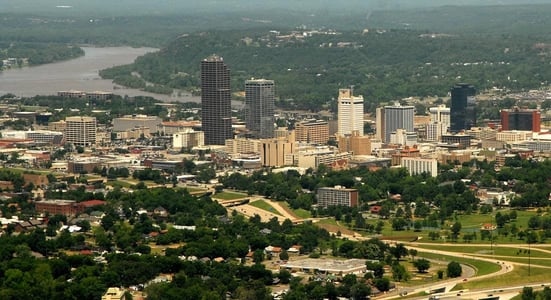
Photo Credit: Photolitherland [CC BY 3.0], from Wikimedia Commons
Despite being the capital, Little Rock’s residents don’t have the most strenuous commute, driving only 18.6 minutes for work. The largest industry in the city is healthcare and social assistance, with the retail, education, and hospitality industries the next-largest (in descending order).

Buying a house in Little Rock comes with a median cost of $154,700, more than $60,000 below the national average. Low prices help residents become homeowners, and the homeownership rate in Little Rock is 56.1%.
The University of Arkansas at Little Rock is the most prominent university in the city, and the University of Arkansas for Medical Sciences is also located within the city. The Little Rock School District oversees more than 50 schools, including the Arkansas School for the Blind and the Arkansas School for the Deaf.
“I must say that we are really enjoying Little Rock and all the small towns in the area. I have lived in 4 different states and so far this is my family’s favorite. I have four children under the age of ten and we do stuff almost every weekend. Lots of free or inexpensive things to do. We go to the river market a lot as we always have a great time there. After living in other places I will tell you the cost of living here is way better than others.” — Review of Little Rock, Arkansas
Little Rock residents have a huge variety of options for entertainment, starting with exploring the area’s history at one of the many nearby historic sites and museums, including the Arkansas Korean War Veterans Memorial and the Arkansas Inland Maritime Museum.
The Arkansas Arts Center is a great place to view the art installations or take in a family show from the professional theatre company. The Arkansas Arts Center Children’s Theatre also puts on regular productions perfect for the whole family.
The Little Rock Zoo and Donald W. Reynolds Science Center are perfect stops for an educational afternoon. And the Wild River Country water park is a great way to beat the Little Rock heat in the summertime. Plus, sports fans can cheer on the Arkansas Travelers as they take the field at the Dickey-Stephens Park.
15. Lansing, Michigan
Though explored several times throughout the early 1800s, Lansing, Michigan, the city was not official until 1848, when it was given its name — and, within months, became the capital of Michigan. While the city of Detroit far outpaced Lansing in terms of population, the capital city currently houses around 115,000 residents.
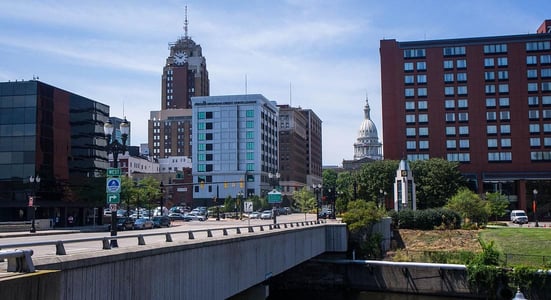
Photo Credit: Davidshane0 [CC BY-SA 3.0], from Wikimedia Commons
Of all of our cities, Lansing has the fewest businesses, home to just 9,434 firms. Residents are most likely to work in the retail industry, though the healthcare and social assistance, manufacturing, and education industries are also among the top areas for employment.

Lansing’s median housing prices is more than $140,000 lower than the national average, coming in at just $75,500. Despite this affordability, homeowners only slightly outnumber renters with a homeownership rate of 50.4%.
Located in nearby East Lansing, Michigan State University is by far the largest higher education institution in the area, and the private Western Michigan University Thomas M. Cooley Law School is one of the largest in the country. Many residents also attend the Lansing Community College or one of the cities several smaller colleges.
“We love it here. My husband loves his job. My son loves his school. It has been affordable. The people are friendly. Tons of fun things to do every season all over this state. Lots of festivals and fairs and lots of culture and beauty.” — Review of Lansing, Michigan
When it comes to staying busy, Lansing residents have many options for both indoor and outdoor activities. The Wharton Center on the MSU campus is popular for its year-round productions, and the Lansing Art Gallery has dozens of engaging exhibits.
Residents can get their science on with a show at the Abrams Planetarium or check out the hands-on exhibits at the Impression 5 Science Center. And they can explore history at the Michigan History Museum and Archives of Michigan, which covers everything from prehistoric times through the late 20th century.
Active residents can take their bikes out to the Anderson Park Mountain Bike Trail or take a stroll through the Harris Nature Center. And the W.J. Beal Botanical Garden is a great place to spend a day outdoors when the weather is nice.
Study Sources & Methodology
We explored a number of different resources to find cities that balance cost of living with a good quality of life, starting with the top 70 cities from Niche.com‘s list of the U.S. cities with the lowest cost of living.
We then evaluated each city’s quality of life, including the local job market, average commute times, poverty rates, average salary, and more. Additional data was sourced through Datausa.io, PayScale.com, and the Census Bureau. Resident reviews were obtained via BestPlaces.net.
Advertiser Disclosure
BadCredit.org is a free online resource that offers valuable content and comparison services to users. To keep this resource 100% free for users, we receive advertising compensation from the financial products listed on this page. Along with key review factors, this compensation may impact how and where products appear on the page (including, for example, the order in which they appear). BadCredit.org does not include listings for all financial products.
Our Editorial Review Policy
Our site is committed to publishing independent, accurate content guided by strict editorial guidelines. Before articles and reviews are published on our site, they undergo a thorough review process performed by a team of independent editors and subject-matter experts to ensure the content’s accuracy, timeliness, and impartiality. Our editorial team is separate and independent of our site’s advertisers, and the opinions they express on our site are their own. To read more about our team members and their editorial backgrounds, please visit our site’s About page.




